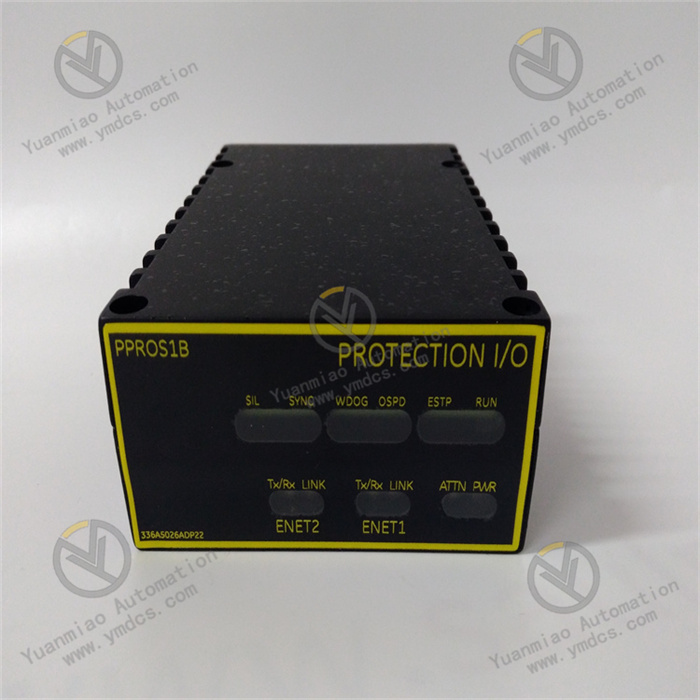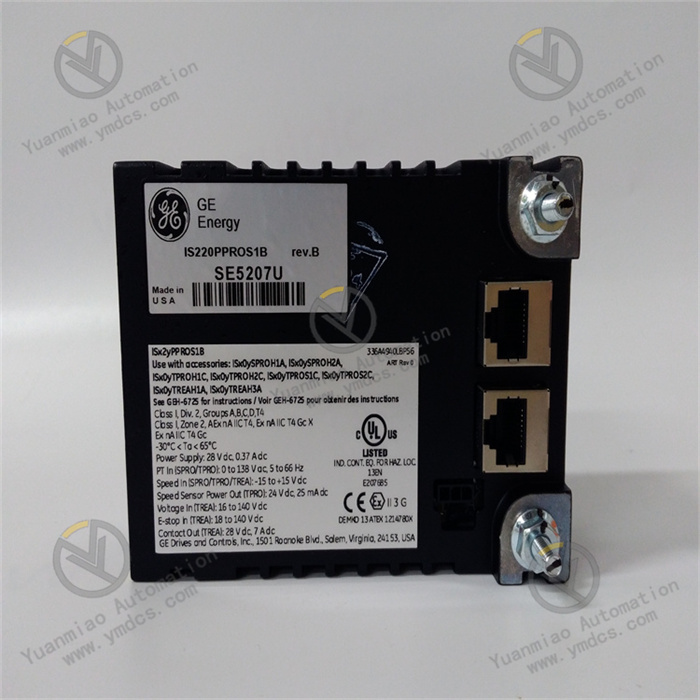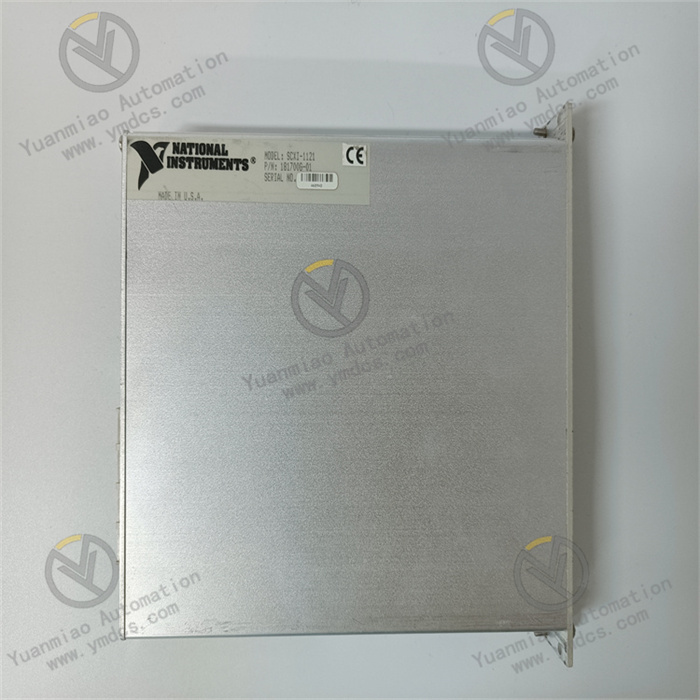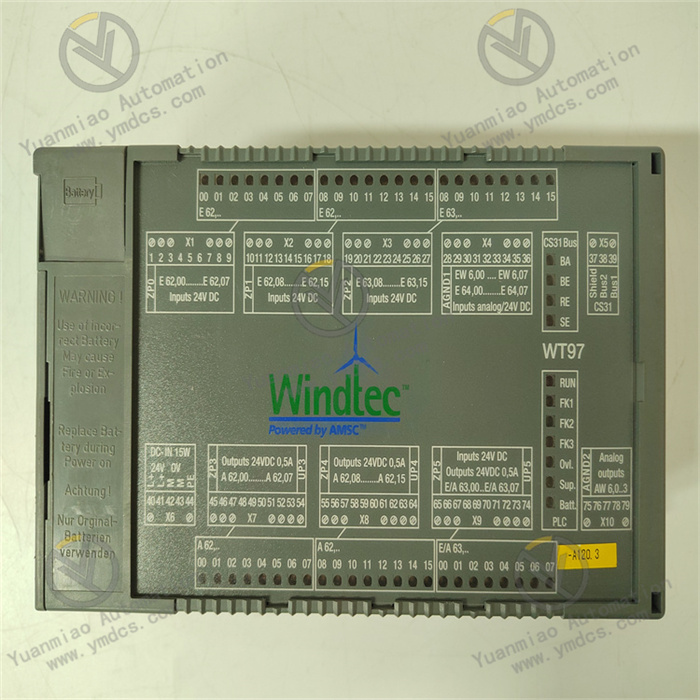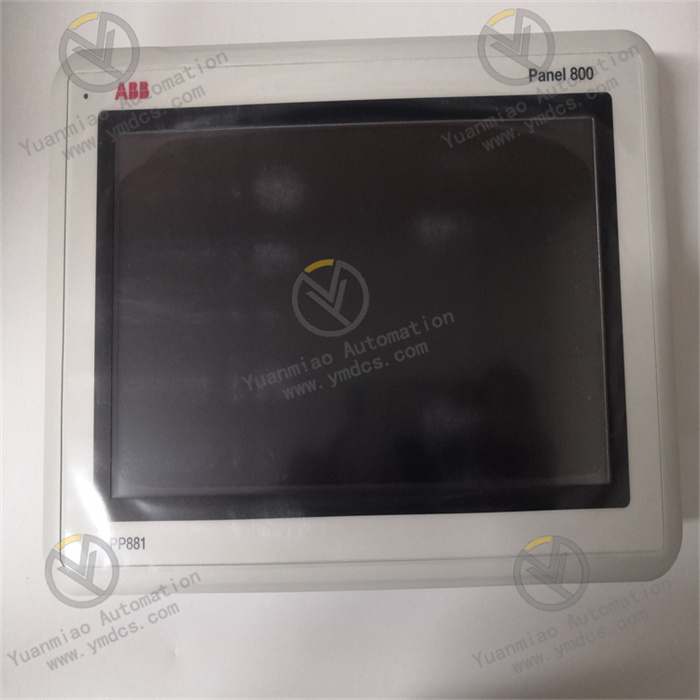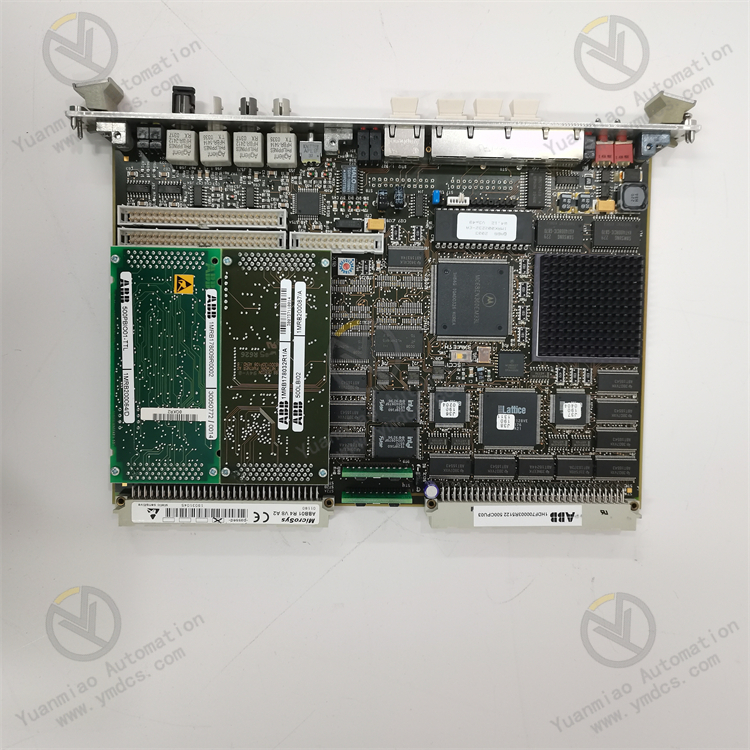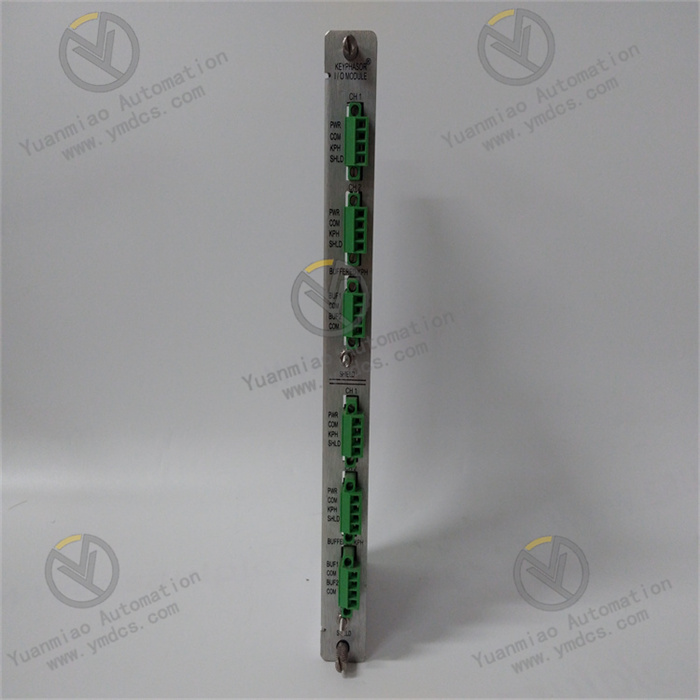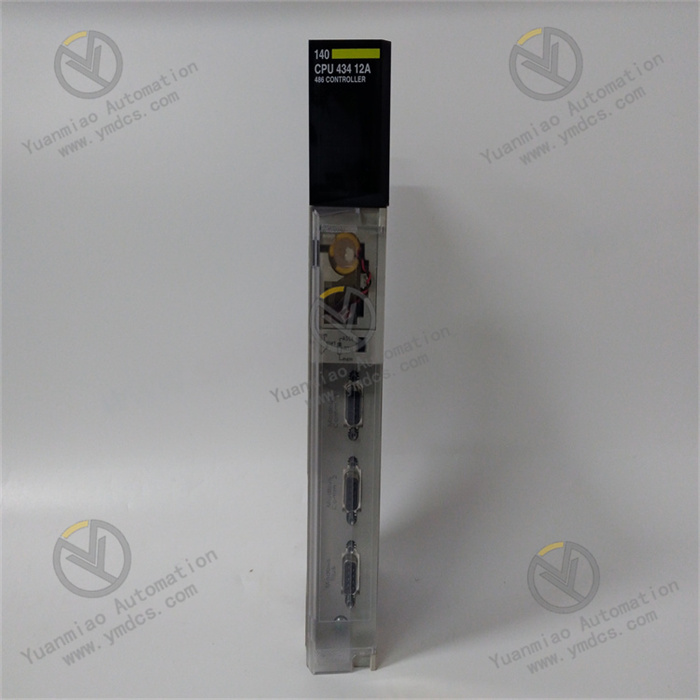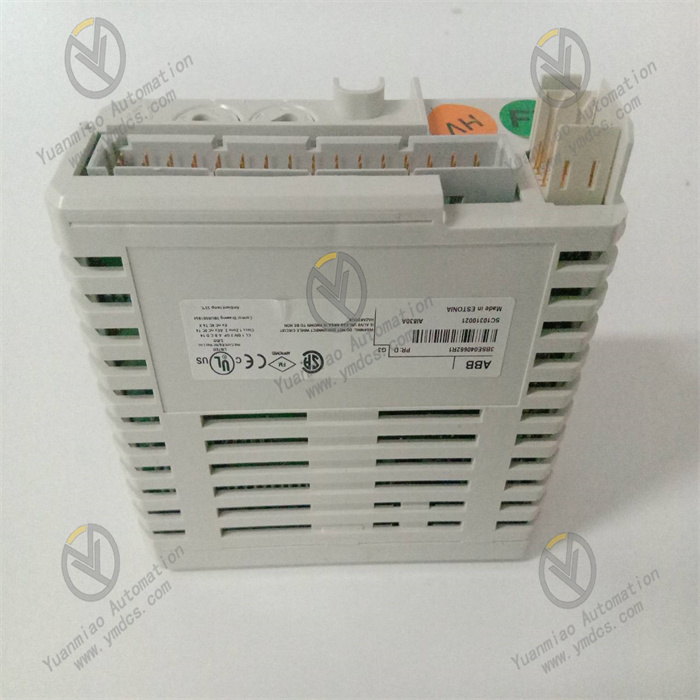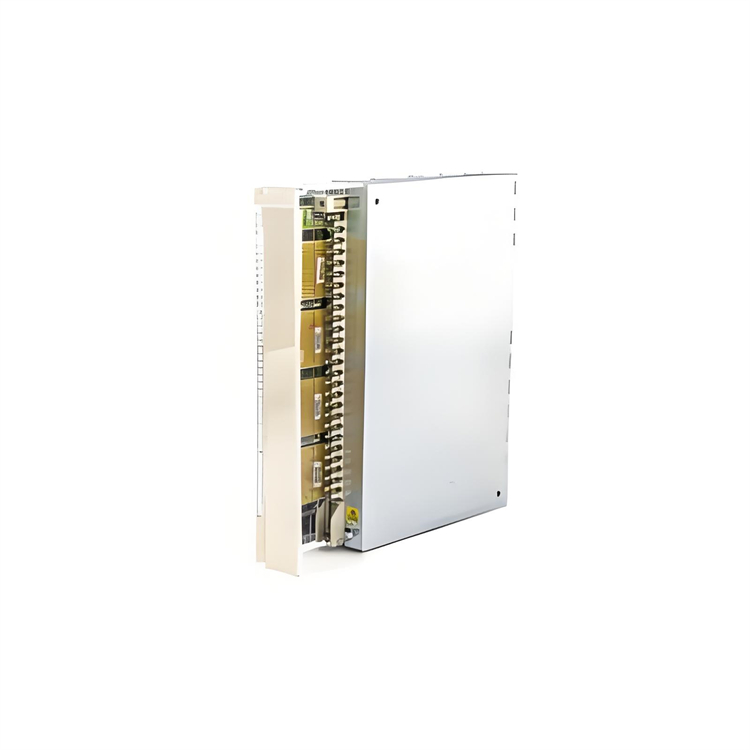Description
GE IS220PPROS1B
I. Overview
The GE IS220PPROS1B is a compact process control module based on the GE Mark VIe control system architecture. It must be used in conjunction with Mark VIe controllers (e.g., IC698CPE020), compact racks (e.g., IC698CHS005), and IS420UCSBH1A communication modules. Its core functions include:
- Collecting key process parameters (such as temperature and pressure, with signal types of 4-20mA/0-10V) via 8 analog input (AI) channels;
- Driving small actuators (e.g., micro control valves, small frequency converters) through 4 analog output (AO) channels;
- Monitoring equipment status (e.g., pump start/stop, valve on/off) via 4 digital input (DI) channels;
- Controlling auxiliary equipment (e.g., solenoid valves, alarm lights) through 4 digital output (DO) channels;
- Incorporating 4 independent PID control loops that support basic PID regulation and split-range control strategies;
- Featuring signal filtering and fault self-diagnosis (channel open circuit/short circuit) functions;
- Supporting parameter configuration via the simplified version of GE Mark VIe Configuration Tool.
Its core advantages lie in "compact channel design (20 I/O channels), high cost-effectiveness (30% lower cost than the IS220PPROH1A), miniaturized size (depth ≤ 180mm), and SIL 1 safety certification". It is particularly suitable for scenarios such as small and medium-sized chemical reactors (controlling 2-3 process variables), district heating boilers (water temperature/water pressure control), and food processing equipment (baking temperature control).
The IS220PPROS1B collects reaction temperature (4-20mA), stirring speed (4-20mA), and feed flow (0-10V) via 8 AI channels, and controls heating rod power (4-20mA), stirring motor frequency converter (4-20mA), and feed valve opening (0-10V) through 4 AO channels. When the reaction temperature deviates from the set value by ±2℃, the module adjusts the heating rod output within 0.2 seconds, maintaining the temperature control accuracy at ±1℃ and avoiding insufficient raw material reaction (with a single batch loss exceeding RMB 50,000). In a 10-ton/hour heating boiler of a residential community, the module collects supply water temperature (4-20mA) and return water pressure (4-20mA) via AI channels, and controls gas valve opening (4-20mA) and circulating pump frequency converter (4-20mA) through AO channels. It operates continuously for 180 days without failure during the winter heating period, with a Mean Time Between Failures (MTBF) of ≥ 800,000 hours, meeting the "seasonal continuous operation" requirement of district heating. In a biscuit baking production line of a food factory, the IS220PPROS1B withstands a high temperature of 45℃ and flour dust environment in the workshop. It collects oven temperature (4-20mA) via AI channels and controls the output of heating tubes through AO channels, with a temperature deviation of ≤ ±3℃, increasing the biscuit qualification rate from 96% to 99%. Meanwhile, the module's miniaturized design is compatible with the compact control cabinet of the production line (occupying only 60% of the space of traditional modules).
The module adopts a "compact channel + miniaturized architecture":
- I/O Channel Design: It includes 8 AI channels (4-20mA/0-10V, 16-bit resolution), 4 AO channels (4-20mA/0-10V, 16-bit resolution), 4 DI channels (24V DC dry contacts), and 4 DO channels (relay output of AC250V/1A). The analog channels are equipped with basic photoelectric isolation (isolation voltage ≥ 1.5kVrms) and fixed low-pass filtering (cutoff frequency of 50Hz) to meet the anti-interference requirements of small and medium-sized scenarios. The digital channels have overvoltage protection (±24V ESD protection for DI channels and built-in 5A fuses for DO channels).
- Core Control Unit: It has a built-in 16-bit fixed-point DSP processor (operating rate of 300 MIPS), supporting parallel processing of 4 PID loops with configurable control cycles (50ms~1s). It is equipped with 8MB Flash (for storing control logic) and 16MB RAM (for caching real-time data) to meet the computing needs of small and medium-sized scenarios.
- Housing and Protection: It uses an ABS flame-retardant housing (UL94 V-0 grade), with dimensions conforming to the 3U standard rack (19 inches) and an installation depth ≤ 180mm, compatible with compact control cabinets. It has an IP20 protection rating (dust-proof and finger-proof), an operating temperature range of -20℃~60℃, a storage temperature range of -40℃~85℃, and a relative humidity of 5%~95% (non-condensing), making it suitable for small and medium-sized workshop environments.
- Safety and Deployment Design: It supports independent operation of a single module (no redundant configuration required, reducing costs), complies with IEC 61508 SIL 1 certification, and adopts basic protection design for key circuits (such as power supply). It supports dual installation methods of DIN rail and rack, enabling flexible deployment. In small control cabinets, it can be directly installed on rails without a dedicated rack.
II. Technical Parameters
1. I/O Channel Parameters
| Parameter Category | Specific Specifications |
|---|---|
| Analog Input (AI) | 8 independent channels, supporting 4-20mA DC (2-wire) and 0-10V DC; 16-bit resolution; accuracy of ±0.1% full scale (at 25℃); input impedance: ≤150Ω for current signals, ≥1MΩ for voltage signals; sampling rate: 50Hz per channel (configurable 10-100Hz) |
| Analog Output (AO) | 4 independent channels, supporting 4-20mA DC and 0-10V DC; 16-bit resolution; accuracy of ±0.2% full scale (at 25℃); output load: ≤300Ω for current signals, ≥1kΩ for voltage signals; response time ≤20ms |
| Digital Input (DI) | 4 independent channels, 24V DC dry contacts (high level ≥18V, low level ≤5V); input current ≤8mA; response time ≤2ms; supporting level detection |
| Digital Output (DO) | 4 independent channels, relay output (AC250V/1A, DC30V/1A); supporting normally open contacts; output protection: built-in 5A fuse |
2. Control Performance Parameters
| Parameter Category | Specific Specifications |
|---|---|
| Processor | 16-bit fixed-point DSP (TI TMS320F28035), operating rate of 300 MIPS, supporting fixed-point PID calculation |
| PID Control Loops | 4 independent PID loops, supporting basic PID regulation and split-range control; cascade/feedforward control not supported (adapted to small and medium-sized scenarios) |
| PID Parameter Configuration | Proportional band (P): 5%~500%, integral time (I): 1s~500s, derivative time (D): 0~50s; supporting manual tuning |
| Control Cycle | Configurable 50ms~1s, minimum control cycle of 50ms (adapted to the response needs of small and medium-sized equipment) |
| Data Processing Functions | Supports fixed low-pass filtering (50Hz), linearization processing (8-segment polyline), and range conversion (0-100% customizable) |
| Fault Alarm Function | Supports alarms for AI channel open circuit, AO channel short circuit, and power supply abnormality; alarm methods: LED indicator + software prompt |
3. Environmental and Electrical Parameters
| Parameter Category | Specific Specifications |
|---|---|
| Operating Temperature | -20℃~60℃ (natural cooling, no rack air duct required) |
| Storage Temperature | -40℃~85℃ |
| Relative Humidity | 5%~95% (non-condensing), complying with the IEC 60068-2-38 humidity cycle standard (1000 hours of fault-free operation) |
| Electromagnetic Interference Resistance | Emission: EN 55032 Class B; Immunity: EN 61000-6-2 (ESD ±8kV air discharge, EFT ±2kV power port) |
| Vibration Resistance | Complies with the IEC 60068-2-6 standard: 10-500Hz, 1g acceleration (continuous operation) |
| Power Supply Requirements | Powered by the Mark VIe compact rack: +5V DC (±5%), maximum power consumption ≤8W; +24V DC (±10%), used for I/O isolation, maximum power consumption ≤4W |

III. Functional Features
1. Compact Channel Design, Adapting to the Needs of Small and Medium-Sized Scenarios
With "on-demand configuration" as its core, the IS220PPROS1B addresses the pain points of traditional full-channel modules, such as "high cost and large space occupation":
- Matching Low-Variable Control: The channel combination of 8 AI + 4 AO + 4 DI + 4 DO fully covers the control needs of 2-3 process variables in small and medium-sized equipment (e.g., "temperature + pressure + flow" control for reactors), avoiding resource idleness caused by the 40 I/O channels of the IS220PPROH1A. In a district heating boiler, only 2 AI channels (water temperature/water pressure) and 2 AO channels (gas valve/circulating pump) are needed to meet control requirements, achieving a 100% module channel utilization rate and a 30% lower cost than the IS220PPROH1A.
- Miniaturized Deployment: The compact design with a depth of ≤180mm is compatible with small control cabinets with a width of only 150mm. In a baking production line of a food factory, the module is installed side by side with the IS420UCSBH1A communication module, occupying only 1/3 of the control cabinet space and avoiding the "overcapacity" space waste of traditional modules.
- Simplified Wiring: The reduced number of channels lowers on-site wiring workload. During the commissioning of a fine chemical reactor, the wiring time is shortened from 8 hours (with traditional modules) to 3 hours, and the training cost for operation and maintenance personnel is reduced by 50% (only basic PID parameter setting needs to be mastered).
2. Basic PID Regulation, Balancing Accuracy and Usability
In response to the characteristic of "low professionalism of operation and maintenance personnel" in small and medium-sized scenarios, the module reduces operation difficulty by simplifying control algorithms:
- Focusing on Core Regulation: The 4 independent PID loops support basic PID and split-range control, meeting the needs of 90% of small and medium-sized scenarios (e.g., PID regulation of water temperature in heating boilers, split-range control of reactor temperature). Complex strategies such as cascade and feedforward control are removed to avoid cumbersome parameter tuning. In a residential community heating boiler, operation and maintenance personnel only need to set the "target water temperature of 60℃", and the module automatically adjusts the gas valve opening without complex parameter configuration.
- Guidance for Manual Tuning: It provides guidance for manual PID parameter tuning (e.g., "increase the proportional band if temperature fluctuation is large") and is equipped with a simplified configuration software (retaining only the core parameter interface). A new operation and maintenance personnel in a chemical enterprise can complete the PID tuning of reactor temperature within 1 hour, which is significantly shorter than the 3-day learning cycle of the professional software for the IS220PPROH1A.
- Stable Control Accuracy: Although the accuracy of AI (±0.1% FS) and AO (±0.2% FS) is slightly lower than that of the IS220PPROH1A, it fully meets the needs of small and medium-sized scenarios (e.g., ±3℃ temperature deviation for food baking). In a biscuit production line, the temperature control accuracy is stably maintained at ±2℃, increasing the product qualification rate by 3%.
3. Balancing High Reliability and Low Cost, Reducing the Burden on Small and Medium-Sized Enterprises
Through the design of "essential protection + simplified redundancy", the module ensures reliable operation while controlling costs:
- Basic Anti-Interference Design: The 1.5kVrms photoelectric isolation and ±8kV ESD protection meet the electromagnetic environment of small and medium-sized workshops (e.g., no high-voltage equipment above 10kV). Near a small heating furnace in a machinery factory (with electromagnetic radiation of 10V/m), the AI signal fluctuation is ≤0.05% FS without false triggering, fully replacing the anti-interference performance of traditional PLCs.
- Long-Life Components: It uses industrial-grade capacitors (temperature resistance of -40℃~105℃) and micro relays (mechanical life of 500,000 cycles), with an average service life of ≥6 years. A district heating boiler has been in continuous use for 5 years without component damage, with an annual maintenance cost of only RMB 200, far lower than the RMB 1,000/year of traditional PLCs.
- Single-Module No Redundancy: The SIL 1 certification allows the operation of a single module (the consequences of failures in small and medium-sized scenarios are relatively minor), eliminating the need for dual-module hot backup. The cost of a single reactor control system in a fine chemical enterprise is reduced from RMB 20,000 (with the IS220PPROH1A) to RMB 14,000, shortening the investment return cycle by 1 year.
4. Cooperating with Communication Modules to Realize Data Interaction and Remote Monitoring
When used in conjunction with the IS420UCSBH1A communication module, it solves the "data island" problem in small and medium-sized scenarios:
- Low-Cost Data Transmission: The IS220PPROS1B is connected via the Modbus RTU protocol (serial interface) of the IS420UCSBH1A, eliminating the need for additional Ethernet wiring. A district heating station aggregates data from the IS220PPROS1B modules of 3 boilers to the central control room via a 485 bus, reducing communication costs by 40% compared with Ethernet solutions.
- Remote Status Monitoring: The IS420UCSBH1A uploads the module's process parameters (e.g., water temperature, valve opening) to a simplified HMI (e.g., touch screen), allowing operation and maintenance personnel to check the status in the central control room without on-site inspection. Through remote monitoring in a food factory, the inspection frequency of baking ovens is reduced from 3 times a day to 1 time, saving 60% of labor costs.
- Fault Linkage Alarm: When the IS220PPROS1B detects an "AI channel open circuit", it triggers a local alarm light via the DO channel and simultaneously uploads the fault signal to the central control room through the IS420UCSBH1A. The fault response time of a chemical reactor is shortened from 30 minutes (traditional method) to 5 minutes, avoiding the expansion of accidents.


